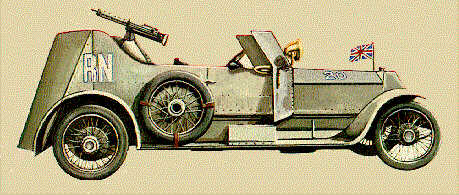![]()
Something new on the Western Front !
|
In 1914, upon the German invasion of Belgium, only a few armoured cars were available
to face the attack; very soon, however, these vehicles proved their capacities in many
fields : from scouting to actual combat against the German cavalry. The Belgians were the first to organize armoured car units. For this purpose Minerva car chassis were assembled with iron plates taken from naval boilers; in spite of this rudimentary approach excellent results achieved by the automitrailleuses suggested French and British allies to implement armoured car squadrons to support infantry action. |
| In addition to the Minervas, the Belgians assigned Sava armoured cars to their scouting units in replacement of cavalry squadrons. |
|
French cavalry units were supplied with several Minerva, Peugeot, and Renault armoured cars armed with either machine guns or with 37 mm guns.
|
|
In the meantime, in the United Kingdom, a unit of R.N.A.S. (Royal Naval Air Service) was assigned to the Dunkirk front to carry out surveillance functions and airplane crew rescue. This unit's automotive equipment included two cars (one Mercedes and one Rolls-Royce Silver Ghost) armed with a machine gun protected by metal plates taken from naval idle boilers, as already made for the Minerva.

Rolls-Royce Silver Ghost
The outstanding results achieved urged the British Admiralty to extend
similar modifications to all the other R.N.A.S. vehicles (cars and trucks) and to
devise a plan for creating the Royal Navy Armoured Cars Division formed by
15 AC squadrons.
Admiralty intentions were to adopt only the Rolls-Royce Silver Ghost model but, due
to the insufficient number of RR chassis available for transformation, it was
necessary to place orders to other car factories : Talbot, Lanchester, Wolseley, etc..
This led to develop a standard model denominated Admiralty Pattern Armoured Car
|
|
|
|
When the western front, in the early months of 1916, was bogged down in
a trench war, armoured cars were progressively replaced by a "new
weapon": the TANK, actually regarded, vis a vis the
terrain constraints, as a better infantry support than ACs, faster but less effective on
soft and muddy soil.
British armoured cars of the dismantled R.N.A.S. were then transferred elsewhere.
On the Russian front where, in addition to the already mentioned Silver Shadows,
saw action the slow Peerless and the Austin, both armed with two machine
guns in a double traverse turret.
|
|
In the Middle East and Egypt the British tested the Sizaire Berwick
armoured car, with its airplane propeller (from which its nickname of "Wind
Wagon"), and the heavy US Seabrook truck, armed with a 360 degree traverse
gun.
|
|
Finally, the Italians were active either in developing armoured vehicles. About 120 Autoblindo Lancia I.Z. armoured cars as well as several Ansaldo "autocannoni" ("self-propelled guns") saw action, with satisfactory results, from the Caporetto defeat (1917) to the final Vittorio Veneto victory (November 4, 1918).
|
|
With the implementation of the armoured cars, tanks, and self-propelled guns, the "trench war" era came to its end. The "moving war" era (about 20 years later the world was going to learn a new word : Blietzkrieg) was forthcoming !
![]()
![]() Please forward your comments (if any) to my Mailbox
Please forward your comments (if any) to my Mailbox
![]()
![]() Back to Klisura 69 homepage
Back to Klisura 69 homepage
Acknowledgment
All the color images (by G.Canestrari) and information have been selected from the "I
Corazzati" book by B.Benvenuti, edited by A.Mondadori - 1976). They are property of
the authors
Page established on : July 15, 1998
Last update : July 15, 1998
This page is maintained by Mario Paesani .....the webmaster !
This page hosted by ![]() Get your own Free
Home Page
Get your own Free
Home Page